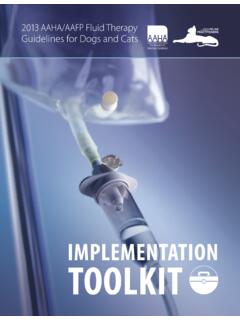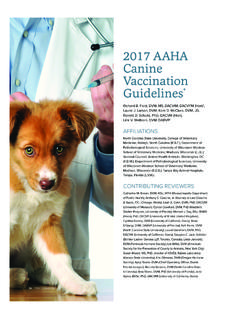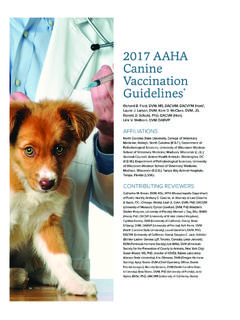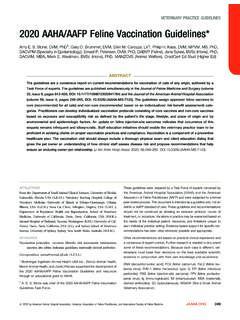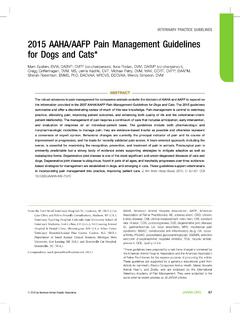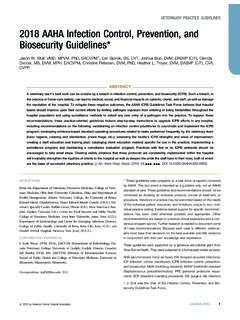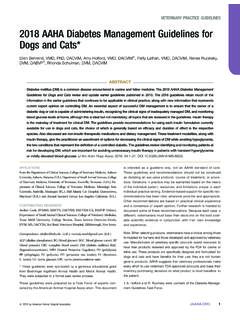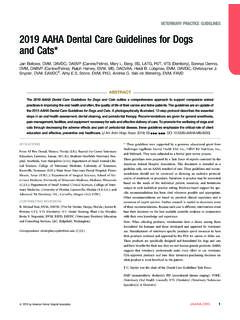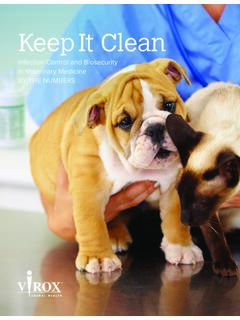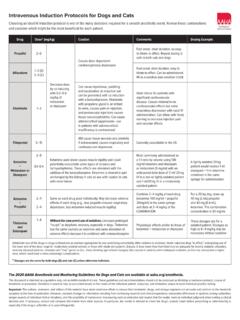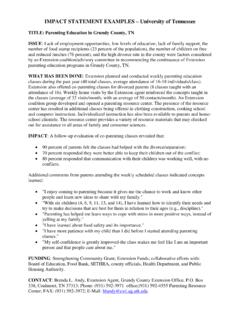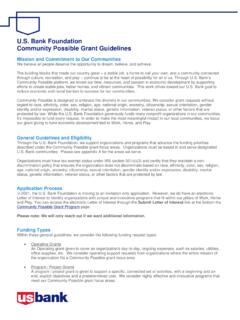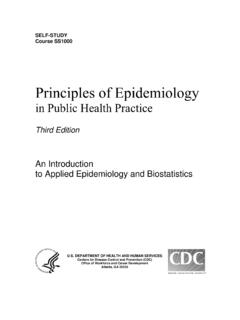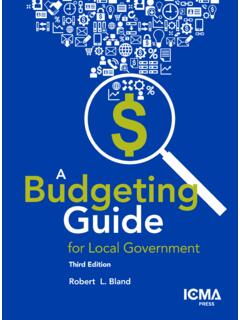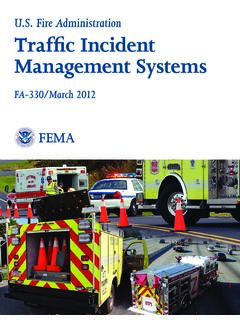Transcription of VETERINARY PRACTICE GUIDELINES ...
1 VETERINARY PRACTICE GUIDELINES2020 AAHA Anesthesia and Monitoring Guidelinesfor Dogs and Cats*Tamara Grubb, DVM, PhD, DACVAAy, Jennifer Sager, BS, CVT, VTS (Anesthesia/Analgesia, ECC)y,James S. Gaynor, DVM, MS, DACVAA, DAIPM, CVA, CVPP, Elizabeth Montgomery, DVM, MPH,Judith A. Parker, DVM, DABVP, Heidi Shafford, DVM, PhD, DACVAA, Caitlin Tearney, DVM, DACVAAABSTRACTRisk for complications and even death is inherent to anesthesia. However, the use of GUIDELINES , checklists, and trainingcan decrease the risk of anesthesia-related adverse events. These tools should be used not only during the time thepatient is unconscious but also before and after this phase. The framework for safe anesthesia delivered as a continuum ofcare from home to hospital and back to home is presented in these GUIDELINES . The critical importance of client commu-nication and staff training have been highlighted. The role of perioperative analgesia, anxiolytics, and proper handling offractious/fearful/aggressive patients as components of anesthetic safety are stressed.
2 Anesthesia equipment selectionand care is detailed. The objective of these GUIDELINES is to make the anesthesia period as safe as possible for dogs andcats while providing a practical framework for delivering anesthesia care. To meet this goal, tables, algorithms,figures, and tip boxes with critical information are included in the manuscript and an in-depth online resource center is available (J Am Anim Hosp Assoc2020; 56:--- ---. DOI )AFFILIATIONSFrom Washington State University College of VETERINARY Medicine, Pullman,Washington ( ); University of Florida VETERINARY Hospitals, Gainesville,Florida ( ); Peak Performance VETERINARY Group, Breckenridge, Colorado( ); University of California, Davis, School of VETERINARY Medicine, Davis,California ( ); Pima Pet Clinic, Tucson, Arizona ( ); VETERINARY An-esthesia Specialists, Clackamas, Oregon ( ); and Wheat Ridge AnimalHospital, Wheat Ridge, Colorado ( ).CONTRIBUTING REVIEWERSR alph Harvey, DVM, MS, DACVAA (Small Animal Clinical Sciences [Re-tired], College of VETERINARY Medicine, University of Tennessee, Knoxville,TN); David D.
3 Martin, DVM, DACVAA (Private consultant, Kalamazoo, MI).Correspondence: ( ); ( )*These GUIDELINES are supported by generous educational grants fromIDEXX Laboratories, Inc., Midmark, and Zoetis Petcare. They weresubjected to a formal peer-review process. T. Grubb and J. Sager were cochairs of the Anesthesia and Monitoringtask GUIDELINES were prepared by a Task Force of experts convenedby the American Animal Hospital Association. This document is inten-ded as a guideline only, not an AAHA standard of care. These guidelinesand recommendations should not be construed as dictating an exclu-sive protocol, course of treatment, or procedure. Variations in practicemay be warranted based on the needs of the individual patient, re-sources, and limitations unique to each individual PRACTICE support for specific recommendations has been citedwhenever possible and recommendations are based on practical clinical experience anda consensus of expert opinion.
4 Further research is needed to documentsome of these recommendations. Because each case is different, vet-erinarians must base their decisions on the best available scientific ev-idence in conjunction with their own knowledge and : When selecting products, veterinarians have a choice amongthose formulated for humans and those developed and approved byveterinary use. Manufacturers of VETERINARY -specific products spendresources to have their products reviewed and approved by the FDA forcanine or feline use. These products are specifically designed and for-mulated for dogs and cats and have benefits for their use; they are nothuman generic products. AAHA suggests that VETERINARY professionalsmake every effort to use VETERINARY FDA-approved products and basetheir inventory-purchasing decisions on what product is most beneficialto the (American Association of Feline Practitioners); ASA (AmericanSociety of Anesthesiologists); BP (blood pressure); CRI (continuous rateinfusion); ECG (electrocardiogram); ETCO2(end-tidal carbon dioxide);ETT (endotracheal tube); GER (gastroesophageal reflux); HR (heart rate);IM (intramuscular); NSAID (nonsteroidal anti-inflammatory drug); NRC(nonrebreathing circuit); PPV (positive pressure ventilation); RC (rebreath-ing circuit); RR (respiratory rate).
5 SpO2(percentage of hemoglobin sat-urated with oxygen) 2020 by American Animal Hospital statement there are no safe anesthetic agents, there are no safeanesthetic procedures, there are only safe anesthetists should be thedictum for the entire anesthetic process in every team has the crucial role of identifying patient comor-bidities and procedure risks and minimizing the detrimental effectsof perioperative pain and stress in order to provide safe and effi-cacious anesthesia for each patient. In addition, anesthesia is notlimited to the period when the patient is unconscious but is acontinuum of care that begins before the patient leaves home andends when the patient is returned home with appropriate physio-logic function and absent or minimal pain levels. At home, thecontinuum begins with the pet owner administering prophylacticdrugs like analgesics and anxiolytics as well as fasting the pet. In thehospital, the anesthesia continuum includes all of the following fourphases of anesthesia: preanesthesia, induction, maintenance, andrecovery.
6 Anesthesia starts with a preanesthetic evaluation and sta-bilization (if necessary) of the patient, preparation of all of theanesthetic equipment, and selection of appropriate drugs withprecise calculation of drug dosages for all phases of anesthesia. In-duction and careful intubation followed by intraoperative moni-toring and physiologic support in the maintenance phase are thenext steps, with continued monitoring and support into the re-covery phase. Postanesthesia care, as communicated by the veteri-nary staff with the pet owner in the clinic and at home, completesthe continuum. Provision of analgesia and client/staff communica-tion and education are critical throughout the entire objective of these GUIDELINES is to make the anesthesiaperiod as safe as possible for dogs and cats while providing a practicalframework for delivering anesthesia care before, during, and after theanesthetic procedure. The GUIDELINES are intended to be compre-hensive but neither all-inclusive nor a single source for informationand clinical recommendations.
7 More detailed references are availablefor pain management2and cat-specific anesthetic and analgesicneeds,3and academic anesthesia textbooks address disease-, breed-,and procedure-specific anesthesia recommendations and , the GUIDELINES are designed to be as actionable as pos-sible. With that in mind, readers willfind the GUIDELINES visualcomponents to be particularly useful. Algorithms,figures, tips boxes, and tables provide quick access to the essential resources andmethods associated with anesthesia. An online resources center( ) is also available for more detailed 1: PreanesthesiaIndividualized Anesthetic/Analgesic Plan andClient CommunicationAn individualized anesthetic plan with specific and sequential stepsensures the continuum of care throughout the entire anestheticprocess. A complete anesthetic plan must address all phases of an-esthesia, with inclusion of perioperative analgesia throughout eachphase. Although each patient should be treated as an individual,having a set of anesthesia plans that are used repeatedly is appro-priate.
8 This allows the anesthesia team a level of comfort with theiranesthesia protocols while adjusting plans based on individual pa-tient preanesthesia phase includes not only the choice ofpreanesthetic sedatives and analgesics but also a full preanestheticevaluation and stabilization of the patient, if necessary. Categori-zation of patients using the American Society of Anesthesiologists(ASA) Patient Status Scale (scoring of 1 5) provides a frameworkfor evaluation of patient health and determination of stabilizationrequirements prior to anesthesia (available at ).An increase in ASA status from 1 or 2 to 3, or from 3 to 4 or 5,increased the odds of anesthesia-related death in dogs and another study, an ASA status of$3 increased the odds ofanesthesia-related death when compared with an ASA statusof#2, with cats having a higher odds ratio than dogs for anes-thetic ,5 Risks specific to the patient s size and age and the surgical ormedical procedure need to be 6 Disease-related risksshould be corrected or minimized if possible (see textbox PotentialAnesthesia Risk Factors and Actions to Mitigate Risk ).
9 6 8 Monitoring of physiologic parameters and provision of physi-ologic support are integral to the plan in order to reduce the like-lihood of adverse 6 Also critical is a plan for anestheticrecovery and for postdischarge 6 Resources such as staffing,Recommended ResourcesRelated Resources2015 AAHA/AAFP Pain Management GUIDELINES for Dogs and Cats( )2015 AAHA Canine and Feline Behavior Management GUIDELINES ( )2018 AAFP Feline Anesthesia GUIDELINES ( )2019 AAHA Dental Care GUIDELINES for Dogs and Cats( )2013 AAHA/AAFP Fluid Therapy GUIDELINES for Dogs and Cats( )2019 AAHA Canine( ) and2010 Feline( )Life Stage Guidelines2 JAAHA|56:2 Mar/Apr 2020equipment, and drug availability should be considered throughoutthe entire anesthetic further minimize patient risk, use of an anesthesia-surgerychecklist (available at ) helps prevent practicesfrom committing critical oversights and errors in the peri- andintraoperative periods. These patient safety checklists can be createdfor every sedation or general anesthesia procedure, as part of thepatient s medical 1: Preanesthetic Evaluation and Plan ConsiderationsPreanesthetic EvaluationThe preanesthetic patient evaluation is critical for patient safety as itpromotes identification of individual risk factors and underlyingphysiologic changes or pathologic compromise that will impact theanesthetic plan.
10 Factors to be evaluated include the following: History:Identify risk factors such as known medical conditionsand previous adverse drug responses. Clarify the use of allprescribed and over-the-counter medications ( , aspirin,herbal products, cannabidiol, and supplements) to avoid ad-verse drug any abnormal clinical signs, bothacute and chronic, with individual questions specifically di-rected at the cardiovascular, respiratory, gastrointestinal, ner-vous, and musculoskeletal/mobility systems. Records should beevaluated for previous anesthetic events, and client communi-cation should include specific questions regarding satisfactionwith previous anesthetics and recoveries. A smooth recoverymay be noted in the hospital, but the patient may go home andexhibit abnormal behaviors such as lethargy, nausea, vomiting,restlessness, and vocalization, which could indicate pain orother complications that need to be addressed. Physical examination:A thorough physical examination shouldbe completed and documented within 12 24 hr previous toanesthesia and repeated just prior to anesthesia if acute clinicalchanges occur.
